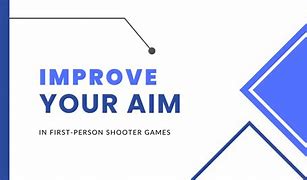How To Improve Your Aim In First-Person Shooter Games Like A Pro
First-person shooter (FPS) games are all about precision and accuracy. Whether you’re a casual gamer or a competitive esports athlete, having good aim is essential to success. But mastering your aim isn’t just about luck; it takes deliberate practice, understanding of the fundamentals, and implementing pro-level strategies.
Understanding The Fundamentals of FPS Aim:
Before you can start working on your aiming skills, you need to grasp the fundamentals. These building blocks will form the foundation for your future improvement.
Sensitivity and DPI: Finding the Sweet Spot
Sensitivity and DPI (Dots Per Inch) are crucial settings that control how your mouse movement translates into in-game cursor movement. If your sensitivity is too high, your cursor will move erratically, making it hard to track targets. But if it’s too low, you’ll find yourself struggling to make quick adjustments. Finding the perfect balance for you requires experimentation.
Mouse Grip and Movement: Ergonomics for Precision
The way you hold and move your mouse significantly impacts your aiming. A comfortable and ergonomic grip allows for smooth, controlled movements, while an awkward grip can lead to strain and inaccuracy. Experiment with different grips, like the palm grip, claw grip, or fingertip grip, to see what feels best for you.
Crosshair Placement and Target Acquisition
Crosshair placement is paramount in FPS games. A good rule of thumb is to keep your crosshair positioned where you anticipate enemies to appear, allowing you to react quickly and efficiently. Practice “target acquisition” – identifying targets and instantly placing your crosshair on them.
Mastering Aim Training Techniques:
Now that you’ve got a firm grasp on the fundamentals, it’s time to move onto consistent training.
The Importance of Consistent Practice
Aim training is an ongoing process. Just like any skill, it takes time and effort to master. Set aside dedicated time for practice sessions, even if it’s just for 15-30 minutes each day. You’ll notice improvements over time, and consistency is key.
Utilizing Aim Trainers and Bots
Aim trainers are specialized tools that help you practice your aiming skills in a controlled environment. These programs offer various training modes, such as tracking targets, flicking between targets, and shooting at moving bots. Use aim trainers to improve your hand-eye coordination and muscle memory.
Warm-Up Routines for Peak Performance
Before you jump into a match, warm up your aiming muscles with a quick routine. Practice target acquisition, flicking, and tracking drills to get your aim sharp. Warming up can improve your reaction times and help you perform at your best.
Pro Tips for Sharpening Your Aim:
Now that you’re comfortable with the fundamentals and have some training under your belt, let’s explore advanced techniques and pro-level tips to enhance your aiming skills.
Practice Tracking and Flicking
Tracking targets is all about maintaining your crosshair on a moving target. Practice tracking slow-moving targets first, then gradually increase the speed and difficulty. Flicking is the ability to quickly move your crosshair from one target to another, and it requires precision and timing.
Mastering Anticipation and Leading Shots
In FPS games, it’s often necessary to anticipate where your target will be in the future. This is called “leading your shots,” and it’s crucial for hitting moving targets. This involves predicting your opponent’s movement and adjusting your shot placement accordingly.
Optimizing Graphics Settings for Clarity
Your graphics settings can impact your aiming ability. Ensure your game settings are optimized for clarity and visibility. Use higher resolution settings and adjust other settings like anti-aliasing and shadows to improve your visual perception.
Mental Fortitude and Game Awareness:
Aiming is only one part of the equation. Mental preparedness and game awareness are crucial for success in competitive FPS gaming.
Staying Calm Under Pressure
When the pressure is on, it’s easy to get flustered and make mistakes. Practice staying calm and focused, even during intense moments. Deep breathing exercises can help you maintain composure and improve your overall performance.
Developing Game Sense and Reading Opponents
Game sense refers to your understanding of the game’s dynamics, including map knowledge, common enemy strategies, and predicting your opponent’s movements. By developing game sense and learning to read your opponents, you can anticipate their actions and improve your overall gameplay.
Leveraging In-Game Features and Tools:
Most FPS games offer a range of features and tools that can help you improve your aim.
Utilizing Aim Assist (If Applicable)
Some games offer aim assist, which helps to automatically adjust your crosshair towards targets. While it can be helpful for beginners, it’s important to note that over-reliance on aim assist can hinder your development as a player.
Understanding Weapon Recoil Patterns
Each weapon in an FPS game has a unique recoil pattern. Understanding these patterns is crucial for maintaining accuracy during sustained fire. Practice controlling recoil by using the mouse to counter the upward movement of your crosshair.
Utilizing Customizable Crosshairs
Most FPS games allow you to customize your crosshair, including its size, color, and shape. Experiment with different crosshair styles to find one that suits your preferences and improves your aiming.
Analyzing Your Gameplay and Identifying Weaknesses:
To improve your aim, you need to analyze your gameplay and identify areas where you can improve.
Demystifying Aim Statistics and Data
Most FPS games offer statistics and data that can provide valuable insights into your performance. Analyze your aim statistics, such as accuracy, headshot percentage, and kill-to-death ratio, to identify areas that need improvement.
Reviewing Game Footage for Improvement
Reviewing your game footage can offer a valuable perspective on your gameplay. Watch back your matches and identify any recurring mistakes or weaknesses. Analyze your aiming, decision-making, and overall game sense.
Seeking Feedback from Experienced Players
Don’t hesitate to ask for feedback from experienced players. They can offer valuable insights into your gameplay and provide constructive criticism to help you improve.
Conclusion:
Improving your aim in FPS games takes dedication and consistent practice. By understanding the fundamentals, utilizing aim training techniques, and incorporating pro tips into your gameplay, you can elevate your aiming skills to new heights. Remember to stay patient, be analytical, and enjoy the journey of becoming a more proficient shooter.
FAQ:
Q: What is the best sensitivity and DPI setting for FPS games?
A: There is no one-size-fits-all answer to this question, as the best settings depend on personal preference and the game you’re playing. Experimentation is key to finding what works best for you.
Q: Are aim trainers necessary for improving aim?
A: While not strictly necessary, aim trainers can be very helpful for improving your aiming skills. They offer controlled environments where you can practice specific aspects of aiming, such as tracking and flicking.
Q: How much time should I spend practicing aim each day?
A: The amount of time you spend practicing depends on your individual goals and schedule. Even 15-30 minutes of dedicated practice can make a difference over time.
Q: How do I stay calm and focused during intense moments in an FPS game?
A: Deep breathing exercises, meditation, and mindfulness techniques can help you stay calm and focused under pressure. You can also try practicing in pressure-inducing situations, like playing against skilled opponents or in competitive matches.
Q: How can I learn to read my opponents and anticipate their movements?
A: Understanding common enemy strategies, map knowledge, and observing opponent behavior can help you develop game sense and read your opponents. Watch professional players and learn from their strategies and decision-making.

